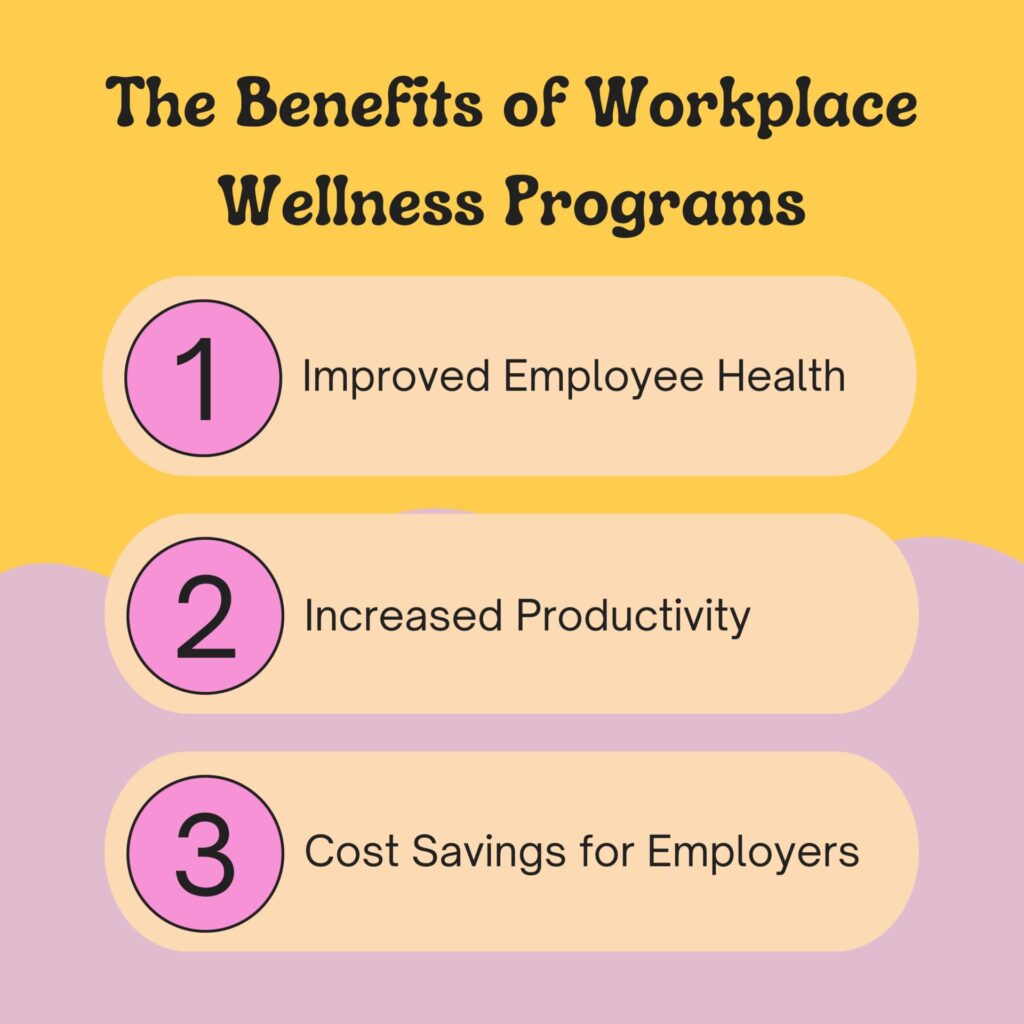Discover how workplace wellness programs enhance employee health, boost productivity, and reduce costs. Explore strategies and benefits now!
Introduction
Workplace wellness programs are increasingly becoming a cornerstone of modern business strategies. These initiatives are designed to promote the overall well-being of employees, creating a healthier, more productive work environment. As organizations recognize the profound impact of employee health on productivity and company success, workplace wellness programs have evolved to address a wide range of health and lifestyle factors.
Definition of Workplace Wellness Programs
Workplace wellness programs are comprehensive strategies implemented by employers to support and enhance the physical, mental, and emotional well-being of their employees. These programs often include a variety of initiatives, such as fitness activities, nutritional guidance, mental health support, and preventive care measures, aimed at promoting healthier lifestyles and reducing health-related issues within the workforce.
Importance and Relevance in Modern Workplaces
In today’s fast-paced work environment, the importance of workplace wellness programs cannot be overstated. With increasing awareness of the correlation between employee well-being and productivity, companies are investing in wellness initiatives to foster a supportive and healthy workplace culture. These programs are relevant for improving employee satisfaction, reducing absenteeism, and enhancing overall organizational performance.
The Evolution of Workplace Wellness Programs
Early Beginnings
The concept of workplace wellness dates back to the early 20th century when companies began to recognize the benefits of maintaining a healthy workforce. Initial efforts were modest, focusing primarily on addressing immediate health concerns and providing basic medical care on-site.
Modern Developments
In recent decades, workplace wellness programs have expanded significantly, incorporating a broader range of health and wellness activities. Modern programs are more holistic, integrating physical fitness, mental health support, and preventive care. Employers now utilize technology, such as wellness apps and online resources, to make wellness initiatives more accessible and engaging for employees.
Future Trends
Looking ahead, workplace wellness programs are expected to continue evolving, driven by advancements in technology and a growing emphasis on personalized health care. Future trends may include the use of wearable devices to monitor health metrics, AI-driven health coaching, and more comprehensive mental health support systems. The focus will likely shift towards creating more individualized wellness plans that cater to the unique needs of each employee.
The Benefits of Workplace Wellness Programs

Improved Employee Health
One of the most direct benefits of workplace wellness programs is improved employee health. Regular health screenings, fitness programs, and nutritional guidance help employees adopt healthier habits, leading to better overall health outcomes.
Increased Productivity
Healthy employees are more energetic, focused, and efficient. Wellness programs that address physical and mental health issues can significantly reduce absenteeism and presenteeism, resulting in higher productivity levels across the organization.
Cost Savings for Employers
By promoting preventive care and healthy lifestyles, workplace wellness programs can reduce healthcare costs for employers. Fewer health issues among employees mean lower insurance premiums and reduced expenses related to medical claims and sick leave.
Components of a Successful Workplace Wellness Program
Physical Health Initiatives
- Fitness Programs: Providing access to fitness programs, whether through on-site gyms, subsidized memberships to local fitness centers, or virtual workout sessions, encourages employees to stay active and maintain physical fitness.
- Nutritional Guidance: Offering nutritional guidance through dietician consultations, healthy cafeteria options, and educational workshops helps employees make informed dietary choices that support their overall well-being.
Mental Health Support

- Counselling Services: Access to counseling services, either on-site or through telehealth options, ensures that employees have the support they need to address mental health issues.
- Stress Management Techniques: Workshops on mindfulness, meditation, and stress management techniques equip employees with the tools to manage stress effectively, improving their mental health and resilience.
Preventive Care and Lifestyle Management
- Health Screenings: Regular health screenings for conditions such as hypertension, diabetes, and high cholesterol can identify potential health issues early, allowing for timely intervention and management.
- Wellness Challenges: Wellness challenges, such as step-count competitions, smoking cessation programs, and sleep improvement initiatives, foster a culture of health and friendly competition, motivating employees to adopt healthier lifestyles.
Designing a Workplace Wellness Program
Creating an effective workplace wellness program requires a strategic approach, focusing on the specific needs of employees and ensuring strong support from leadership.
Assessing Employee Needs
The first step in designing a wellness program is to understand the health and wellness needs of your employees. Conduct surveys, focus groups, and health risk assessments to gather data on their interests, preferences, and health concerns. This information will help tailor the program to address the unique needs of your workforce.
Securing Leadership Support
Leadership buy-in is crucial for the success of any wellness program. Engage senior management by presenting the benefits of the program, including improved employee health, increased productivity, and cost savings. Demonstrating a clear return on investment can help secure the necessary resources and support.
Effective Communication and Engagement
Communicating the details and benefits of the wellness program is essential for encouraging participation. Use multiple channels, such as emails, newsletters, and team meetings, to promote the program. Creating engaging content and offering incentives can also help boost participation rates.
Implementing Wellness Programs
Steps to Launch a Wellness Program
- Develop a Plan: Outline the program’s objectives, components, and timeline.
- Allocate Resources: Ensure you have the necessary budget, personnel, and materials.
- Launch the Program: Roll out the program with a kick-off event to generate excitement and awareness.
- Monitor Progress: Track participation and gather feedback to make adjustments as needed.
Incentivizing Participation
Offering incentives can motivate employees to participate in wellness activities. These can include rewards such as gift cards, extra vacation days, or recognition in company communications.
Creating a Supportive Environment
Fostering a culture of wellness involves more than just offering programs. Encourage healthy behaviors by creating a supportive environment. This can include providing healthy food options, promoting physical activity through walking meetings, and ensuring access to mental health resources.
Measuring the Impact of Wellness Programs
Key Metrics to Track
To evaluate the success of a wellness program, track key metrics such as participation rates, health outcomes, employee satisfaction, and changes in healthcare costs.
Evaluating Program Effectiveness
Regularly assess the program’s effectiveness through surveys and health data analysis. Use this information to determine what’s working and what needs improvement.
Continuous Improvement
A successful wellness program evolves over time. Continuously seek feedback, track progress, and make necessary adjustments to keep the program relevant and effective.
Case Studies of Successful Wellness Programs
Company A: Tech Industry’s Approach
Company A implemented a wellness program focusing on mental health and work-life balance. They provided on-site counseling, flexible work schedules, and mindfulness workshops, resulting in higher employee satisfaction and reduced stress levels.
Company B: Manufacturing Sector’s Strategy
Company B introduced a fitness and nutrition program, offering gym memberships, healthy cafeteria options, and regular health screenings. This led to a noticeable decrease in absenteeism and healthcare costs.
Company C: Small Business Success
Company C, a small business, focused on creating a supportive community. They organized wellness challenges, provided ergonomic assessments, and promoted work-life balance. The program enhanced employee morale and retention rates.
Challenges in Workplace Wellness Programs
Common Obstacles
- Lack of participation
- Limited budget
- Insufficient leadership support
- Employee resistance to change
Strategies to Overcome Challenges
- Increase Engagement: Use targeted communication and incentives to boost participation.
- Maximize Budget: Leverage free or low-cost resources and partner with local organizations.
- Gain Leadership Buy-In: Present data on the benefits and ROI of wellness programs.
- Encourage Employee Buy-In: Involve employees in the planning process and address their concerns.
Future Trends in Workplace Wellness
Technology and Wellness
The integration of technology, such as wearable devices and wellness apps, is transforming workplace wellness programs. These tools offer real-time health data and personalized recommendations, enhancing employee engagement.
Personalized Wellness Programs
Future wellness programs will focus more on personalization, tailoring initiatives to meet individual employee needs and preferences. This approach can lead to higher participation and more significant health outcomes.
Integrative Health Approaches
Integrative health approaches that combine physical, mental, and emotional well-being will become more prevalent. These programs will offer a holistic approach to health, addressing all aspects of employee wellness.
FAQs
What is the main goal of workplace wellness programs?
The main goal is to improve employee health and well-being, leading to increased productivity and reduced healthcare costs.
How can small businesses implement wellness programs?
Small businesses can implement wellness programs by starting with low-cost initiatives, such as wellness challenges, providing access to online resources, and partnering with local health organizations.
What are the cost benefits of wellness programs for employers?
Wellness programs can lead to cost savings through reduced absenteeism, lower healthcare costs, and increased productivity.
How do wellness programs impact employee morale?
Wellness programs can significantly boost employee morale by showing that the company cares about their well-being, leading to higher job satisfaction and engagement.
What future trends should we expect in workplace wellness?
Future trends include the increased use of technology, more personalized wellness programs, and integrative health approaches that address physical, mental, and emotional well-being.
Conclusion
Workplace wellness programs are vital for promoting employee health, enhancing productivity, and reducing costs. By evolving to meet the diverse needs of employees and leveraging advancements in technology, these programs play a crucial role in fostering a supportive and thriving work environment. Investing in workplace wellness is not just beneficial for employees’ well-being but also for achieving long-term organizational success and sustainability.
Author

Avidon Health is transforming how organizations promote healthier lifestyles through behavior change science and technology-driven coaching. Our mission is to empower individuals to achieve better health outcomes while driving measurable business success for our clients.
With over 20 years of expertise in health coaching and cognitive behavioral training, we’ve built a platform that delivers personalized, 1-to-1 well-being experiences at scale.
Today, organizations use Avidon to reimagine engagement, enhance health, and create lasting behavior change—making wellness more accessible, impactful, and results-driven.
